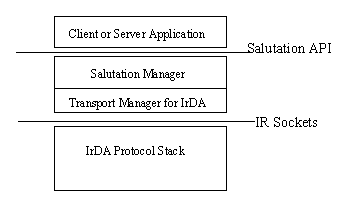

Salutation may be implemented on IrDA through the
Windows Socket interface. The following describes this
technique.
Figure 4 shows the relationship of the Salutation Manager�
with the IrDA Stack and associated applications. This diagram is identical for
both client and server implementations. The Salutation Manager, equipped with a
transport manager specific to the IrDA protocol stack, is accessed by the
application through the Salutation API. The Salutation Manager sends and
receives Salutation Protocol over IrDA through the Windows Socket interface. The
following sections will describe the interchange between these components.

Figure 4: Relationship of Salutation Manager to the IrDA Protocol Stack using unique Transport Manager
When each Salutation Manager is initialized, it starts the IrDA Transport Manager. The Transport Manager calls the IRSocket �socket()�EAPI to build an IR socket. Through the sockets interface, the Transport Manager on the server binds to the socket, sets the IrDA transceiver in listen mode and sets the transceiver to accept any inbound transmissions.
The Transport Manager on the client and service devices performs the function of searching for other devices and determining if these devices are Salutation-enabled.
Using the SetSocketOpt(IAS_SET) call, the service�s Transport Manager sets a Salutation Manager Identifier (SLM-ID) in the IAS registry of the IrDA stack. The IAS_SET structure values are set as follows:
irdaClassName = "SLM"
irdaAttribName = "SLM-ID"
irdaAttribType = 0x00000001
irdaAttribute.irdaAttribInt = an integer specifying an SLM-ID unique to the device
The Salutation Architecture Specification defines the SLM-ID for IrDA as the "IrLAP device address (4 octets), followed by a random value through the 16th octet". Although the IrLAP device address is not universally unique, the SLM-ID should be unique in practice considering the mobile nature of the IrDA protocol and the sufficiently long (11 octets) random value.
The client's Transport Manager searches for other devices using the command loop:
GetSocketOpt(IRLMP_ENUMDEVICES)
When successful, the GetSocketOpt command returns a list of responding devices. The client device's Transport Manager then uses a GetSockOpt(IAS_QUERY) to determine if the found devices are Salutation enabled. If they are Salutation enabled it also discovers the values of their SLM-IDs.
The client�s Transport Manager builds a correlation table between the SLM-ID and the .irdaDeviceID. The client�s Transport Manager is responsible for converting requests to a SLM_ID specific to a .irdaDeviceID.
Finally, the Transport Manager issues a IRSockets connect() command to each of the found Salutation-enabled devices. This causes a new socket handle to be generated on each of the service devices, which in turn establishes an IrDA link between the client and one or more service devices. The Transport Managers maintain this link.
The rest of the
interactions between devices take place through the Salutation Manager via the
Salutation APIs
To establish the
capabilities of Functional Units contained on the device, a service application
uses the slmRegisterCapabilities() call. The service�s
Salutation Manager holds this information and compares it to requests for
service received over the IrDA interface.
Client applications
use the slmSearchCapabilities() call to determine the SLM-ID of devices meeting
the search criteria defined by the application. Search criteria are specified
through one or more Functional Unit Description Records contained in the
slmSearchCapabilities() call. The client Salutation Manager packages this
request into a QUERY_CAPABILITIES Salutation Protocol command and sends it, via
an IRSockets send() command, to all identified Salutation-enabled devices.
Each receiving device
compares the attributes of the received Functional Unit Description Record(s)
with the Functional Unit descriptions registered there. This comparison is
performed via an algorithm specified in the Salutation Architecture
Specification. If there is a positive compare, the service Salutation Manager
packages its response in a QUERY_RESPONSE Salutation Protocol response and sends
this to the client device in an IRSockets send() command. Using the correlation
table, the client Transport Manager
maps the positive response to an SLM-ID which is returned to the application in
response to the slmSearchCapabilities() call, and passes the resulting
information through the Salutation manager to the client.
Client applications
use the slmQueryCapabilities() call to determine the specific capabilities of
one of the service devices. The client specifies which device by specifying an
SLM-ID. Search criteria are again specified through one or more Functional Unit
Description Records contained in the slmQueryCapabilities() call. The client
Salutation Manager packages this request into a QUERY_CAPABILITIES Salutation
Protocol command. The client�s Transport Manager correlates the SLM-ID to the
irdaDeviceID and sends the QUERY_CAPABILITIES command, using an IRSockets send()
command, to the specified device.
The receiving device
compares the attributes of the received Functional Unit Description Record(s)
with the Functional Unit descriptions registered there. This comparison is
performed via an algorithm specified in the Salutation Architecture
Specification. If there is a positive compare, the service�s Salutation
Manager packages its response in a QUERY_RESPONSE Salutation Protocol response
and sends this to the client device in an IRSockets send() command. This
information is passed through the client�s Salutation Manager and is returned
to the client.
When the client has located the service it requires, it may exchange other data through the IRSockets send() and receive() commands. When the communication is complete, the client application calls the IRSockets closeSocket() command.
The service application may use an slmUnregisterCapabilities Salutation Manager call to make a function unavailable to other devices.
Extensions
In the preceding example, the Salutation Architecture has been used on IrDA through the use of WinSockets. Similar techniques can be demonstrated using other Sockets interface to other protocols.
Watch for an application note that discusses the Salutation Service Discovery Protocol on IrDA to be posted in the coming weeks on the Salutation web site www.salutation.org.